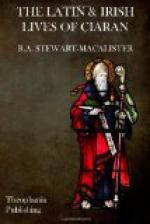Parallels.—There are several cases of the restoration to life of persons who had been decapitated. Coemgen restored two women who had been thus treated (VSH, i, 239). The famous Welsh holy well of Saint Winefred in Flintshire is associated with a similar miracle (see Rees’ Cambro-British Saints, pp. 17, 304). The story of the three murdered monks is also told of Saint Aed (VSH, i, 38), but there the blood-mark round their necks is absent. Ciaran seems to have been less expert than some of his brethren in replacing severed heads on decapitated bodies; for according to a tale preserved in the Book of Lismore, there was a certain lord of the region of Ui Maine (the region west of the Shannon), who was called Coirpre the Crooked, for the following reason: he was an evil man who did great mischief to every one, in consequence of which he was murdered and beheaded. But Ciaran had shriven him, and in order to deliver his soul from demons he restored him to life, replacing his head—so clumsily, however, that it was ever afterwards crooked.
A certain man called Ambacuc, having perjured himself on the hand of Ciaran, his head fell off. He was taken to Clonmacnois, and not only lived there headless for seven years, but became the father of a family![19]
XXXI. HOW CIARAN FLOATED A FIREBRAND ON THE LAKE (LB)
The Harbour of the Island.—It must be remembered, in reading this and other island stories, that as a rule “the harbour of the island” is not, as might be expected, the landing-stage on the island itself, but the port on the mainland from which ships depart to visit the island. Thus Portraine, a place on the coast north of Dublin, is properly Port Rachrann, the Port of Rachra—the port from which voyagers sailed to Rachra, the island now called by its Norse name Lambay.
Parallels.—I have not found an exact parallel, but the story belongs to the same family as that related of Coemgen, who kindled a fire with the drops of water that fell from his fingers after washing his hands (CS, 839).
XXXII. CIARAN IN ARAN (LA, LB, VG)
The Aran Islands.—The marvellous isles of Aran, still a museum of all periods of ancient Irish history, with their immense prehistoric forts and their strange little oratories, were from an early date chosen as the site of Christian communities. Enda ruled over a community at the southern end of the Great Island; the church still survives, in ruin, and bears his name. Ciaran must have remained long enough in Aran to make a permanent impression there, for one of the ancient churches—much later than his time, however—is dedicated under his invocation. The reference to saints “known to God only” reminds us of the dedications to saints “whose names the Lord knows” in Greek on the font of the Church of the Nativity at Bethlehem, and in Armenian on a mosaic pavement at Jerusalem.




